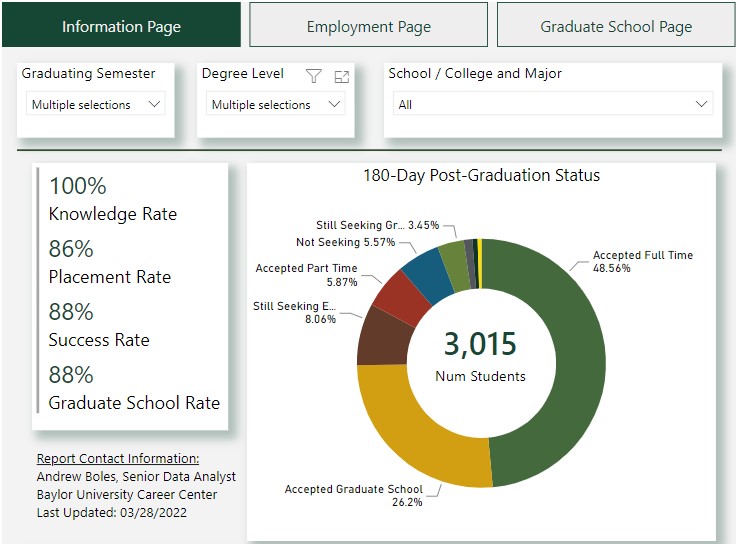(article #3 in 3 part series)
If you would like context for my analysis below, I encourage you to read parts 1 and 2 of this 3 part series:
1. Do Universities Really Care and Share What Happens to Students After College? and
2. Why Don’t Universities Follow Federal Law To Document Post-Grad. Success?
This article is focused on what universities are sharing when it comes to federal requirements on placement data. This is not an analysis based on an experimental design and there is no random selection here. As the title suggests, this is simply a cursory examination of 25 universities and done during the last week of April 2022. Should anyone think that I am trying to pick on any institution, I selected these institutions before I had any idea of their data on this issue. You will see some good institutional variety in the list and while the list may seem somewhat random, the reality is that these are all universities I have either attended, worked at, applied to, or to which I have a unique personal connection. In other words, they are all universities I care about and that I want to succeed.
These are all universities I have either attended, worked at, applied to, or to which I have a unique personal connection. In other words, they are all universities I care about and that I want to succeed.
I made a decision to order the list of institutions not by their placement or success rate, but by their knowledge or response rate. A placement rate of 95% of graduates means little if the university only collected data from 50% of the graduates. The colleges I wanted to highlight at the top were those doing the hard work of collecting accurate data on as many of their graduates as possible.
The data table accompany this article can be found here
For starters, kudos to Baylor University, the only university of the 25 selected to have a 100% knowledge rate! The only other college within 12% of Baylor was Princeton. Baylor’s standard is one I would like to think all colleges will be achieving in coming years. If I worked at a career center, I would be contacting Baylor’s Career Center and learning their secret to a 100% knowledge rate. On the flip side, my hometown Salisbury University reports only a 13% knowledge rate. In other words, Salisbury is publicly sharing that they have a 92% placement rate, quite good for this list of colleges, but the reality is that this only represents a small fraction of their graduates.
Kudos to Baylor University, the only university of the 25 selected to have a 100% knowledge rate!

The other particularly low knowledge rate is the 15% for the U. of Texas Austin, which does not provide an all-university knowledge rate – just one rate for their College of the Liberal Arts which makes up 24% of their undergraduates. However, the U. of Texas was the first in the nation to work with the U.S. Census Bureau since 2018 to document every one of their graduate’s salaries in the nation. This is an incredible accomplishment and as Jeremy Bauer-Wolf in Inside Higher Ed writes:
“This database provides information on students’ median income for every program offered on the 14 UT campuses 1, 5, and 10 years after graduating. It also provides salaries at the 25th and 75th percentiles. The database also shows what percentage of students in each program went on to continue their educations, maps out the median loan debt for different programs, breaks down how much the median monthly loan payment would be and shows outcomes for graduate, medical and dental students separately. To collect the data, UT officials needed to receive security clearance and be fingerprinted. The database took six years to build.”

I reached out to the contact person for this database, wanting to know if other institutions have sought to provide similarly robust salary data. Erika McEntarfer, Lead Economist of the Center for Economic Studies at the U.S. Census Bureau shared the following with me, “Since this UTexas pilot, the Post-Secondary Employment Outcomes work has expanded to cover institutions in 19 states, almost 30% of post-secondary graduates.” Special shout-outs to the public higher education governing bodies of Texas, Indiana, and Virginia, who now provide employment data on over 75% of their state’s college graduates!

Although their knowledge rates were low, at least Salisbury U. and the U. of Texas Austin were transparent and shared their knowledge rates. Three of the colleges provided success rates of 93% or 94%, but all three left their knowledge rate out. For all we know, the career success rate these three colleges are touting could be based on less than 10% of their graduates. How does this help families? If we focus on just the success rates, ignoring the lack of knowledge rates, Washington College, Pseudonym University, and Liberty University have job placement rates higher than both Johns Hopkins and William & Mary. This is possible, but not likely – and we won’t know for sure until they share their knowledge rates.
There were six universities which did not provide any post-graduation placement or career success data. I hope I am mistaken but this could be a violation of federal law. Interestingly, four of the six of these colleges have federal data demonstrating that their graduates’ median earnings would place them within the range of colleges that did provide placement data. My guess is that these six universities have not yet figured out how to collect and share their post-graduation placement and success data.
Another interesting finding is in the gap between the percentage of graduates earning more than a high school graduate compared to the college’s self-reported success rate. I hypothesize that there is a positive relationship between placement success rates and percentages of graduates earning more than high school graduates. The gap between these two numbers at Johns Hopkins and William & Mary is 5%. This indicates that the success rate at two of the most selected colleges on this list is positively related to the percentage of their graduates earning more than a high school graduate. On the other hand, the largest gap between a college’s placement rate and their graduates earning more than high school graduates was 40%. This large difference indicates that although 94% of that college’s graduates are reporting post college success, only 54% are earning more than a high school graduate. However, this is one of the colleges (Liberty) that did not share their Knowledge (Response) Rate – which could be a sign that rate is not very high.
In spite of the federal requirement that all universities share their most recent data, only 5 of the 25 institutions (20%) are providing data on their graduates’ success rates from 2021 (Baylor, Davidson, Johns Hopkins, Princeton, and Westmont). Most of the schools are still sharing the results of their 2020 graduates, although three of the schools are still sharing this data from 2019 (Eastern Mennonite U, Pseudonym U, and the UT Austin). That being said, even this 2-year-old data is better than not reporting any post-graduation data.
Once you look at the data table, the instinct may be to look at two columns. One is for the median salary of graduates which shows, probably not surprising, that Princeton U., Johns Hopkins U., and the U. of Virginia lead the way. Don’t forget that this data on median salary is only for students at those colleges who received federal financial aid. Students who were wealthy enough or scored high enough to receive large merit aid packages (and didn’t therefore need federal aid) are not included. However, my guess is that if the salary data of the wealthy or high achieving students was included, the gap between the top colleges and other colleges in median salary would be even greater.
The second column that I think most people will be drawn to is the success rate. Please remember this caveat, the success rate includes any graduate with a part- or full-time job at any business or place paying them even minimum wage. Of the 19 out of 25 institutions that provided this data, only one had a success rate lower than 85% and the large majority were above 90%. This percentage tells us that most of their graduates were able to find at least part time work or a minimum wage job after graduating.
The bigger picture is that in spite of both the professional association for career placement professionals (NACE) strongly encouraging institutions to self-report “first destination data” (Part 1) and the U.S. Government requiring institutions to share placement data (Part 2), the current state of institutional placement and success reporting, based on this 25 institution sample, might still be described as the “Wild West.” I don’t believe that this will continue, knowing that universities risk losing millions of dollars of federal financial aid for their students if they don’t follow the law. My hope is that we will be more aware of the challenges in interpreting universities’ placement and success data. I do love higher education – but I also know that it is further eroding the trust people have in it and I know more can be done to prevent this.
The data table accompany this article can be found here

